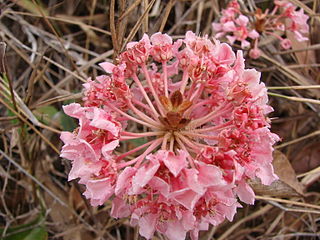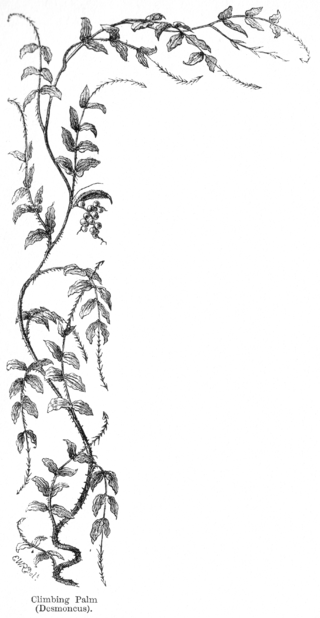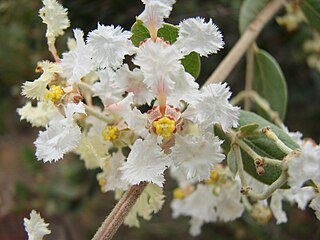
Chusquea is a genus of evergreen bamboos in the grass family. Most of them are native to mountain habitats in Latin America, from Mexico to southern Chile and Argentina.

Oncidium, abbreviated as Onc. in the horticultural trade, is a genus that contains about 330 species of orchids from the subtribe Oncidiinae of the orchid family (Orchidaceae). As presently conceived, it is distributed across much of South America, Central America, Mexico and the West Indies, with one species (O. ensatum) extending into Florida. Common names for plants in this genus include dancing-lady orchid and golden shower orchid.

Pouteria is a genus of flowering trees in the gutta-percha family, Sapotaceae. The genus is widespread throughout the tropical Americas, with outlier species in Cameroon and Malesia. It includes the canistel, the mamey sapote, and the lucuma. Commonly, this genus is known as pouteria trees, or in some cases, eggfruits.

Weinmannia is a genus of trees and shrubs in the family Cunoniaceae. It contains 90 species, which range from Mexico through Central and South America including the Caribbean, and to the Mascarene Islands in the western Indian Ocean. It is absent from mainland Africa and Australia, but some fossils have been attributed to Weinmannia in Australia.

Pterandra is a genus in the Malpighiaceae, a family of about 75 genera of flowering plants in the order Malpighiales. Pterandra comprises 15 species of trees, shrubs, and subshrubs, all but two native to South America, principally Colombia, Venezuela, and Brazil; the exceptions are from Panama. There are only some ornamental plants introduced in China, and there are no native varieties.

Pitcairnia is a genus of plants in the family Bromeliaceae, subfamily Pitcairnioideae. It was named for William Pitcairn, Scottish physician and gardener (1711–1791). The genus Pitcairnia ranks as the second most prolific of the bromeliad family. They are most abundant in Colombia, Peru and Brazil, but can also be found in areas from Cuba and Mexico south to Argentina. One species, Pitcairnia feliciana, is found in tropical West Africa and is the only member of the family Bromeliaceae not native to the Americas.

Desmoncus is a genus of mostly climbing, spiny palms native to the Neotropics. The genus extends from Mexico in the north to Brazil and Bolivia in the south, with two species present in the southeastern Caribbean.

Oenocarpus is a genus of pinnate-leaved palms (Arecaceae) native to Trinidad, southern Central and tropical South America. With nine species and one natural hybrid, the genus is distributed from Costa Rica and Trinidad in the north to Brazil and Bolivia in the south.
Wettinia is a palm genus, consisting of flowering plants in the family Arecaceae. The genus, established in 1837, contains some 20 species, but more seem to await discovery considering that 4 species - W. aequatorialis, W. lanata, W. minima and W. panamensis - were described as late as 1995. The genus is broadly divided into two groups. One group has the fruits tightly packed, while the other, formerly classified as genus Catoblastus, has fruits scattered along the inflorescence branches. It is not known whether these groups are both monophyletic. The genus is named after Frederick Augustus II of Saxony, of the House of Wettin.

Nothocercus is a genus of birds in the tinamou family. This genus comprises three species of this South American family.

Brunellia is a genus of trees. They are distributed in the mountainous regions of southern Mexico, Central America, West Indies, and South America. Brunellia is the only genus in the family Brunelliaceae. As of 2001 there were about 54 species.
Spachea is a genus in the Malpighiaceae, a family of about 75 genera of flowering plants in the order Malpighiales. Spachea comprises 6 species of shrubs and trees growing in wet forests. One species occurs in Cuba, 2 species in southern Central America with one of those also in adjacent Colombia, and 3 species in northern South America. Spachea correae, native to Costa Rica and Panama, is listed in the IUCN Red List of Threatened Species.
Diacidia is a genus in the Malpighiaceae, a family of about 75 genera of flowering plants in the order Malpighiales. Diacidia comprises 11 species of trees, shrubs, and subshrubs. Ten species are found on the mountains of southern Venezuela and adjacent Brazil; one species is widespread in the drainages of the Rio Negro and the Río Vaupés in Venezuela, Colombia, and Brazil.
Glandonia is a genus in the Malpighiaceae, a family of about 75 genera of flowering plants in the order Malpighiales. Glandonia comprises 3 species of trees or shrubs native to lowland forests along rivers or in areas periodically flooded in Amazonian Colombia, Venezuela, and Brazil.
Burdachia is a genus in the Malpighiaceae, a family of about 75 genera of flowering plants in the order Malpighiales. Burdachia comprises 3 species of trees and shrubs occurring in lowland forests near rivers or in low, periodically flooded places in Guyana and Amazonian Venezuela, Colombia, Brazil, and Peru.
Callaeum antifebrile is a South American jungle vine of the family Malpighiaceae which occurs predominantly throughout the Upper Amazon basin, and less frequently along the Lower Amazon. Occasionally a component in ayahuasca decoctions, it is used as a folk medicine in some parts of Brazil, often as an antifebrile (anti-fever) remedy.
Dicella is a genus in the Malpighiaceae, a family of about 75 genera of flowering plants in the order Malpighiales. Dicella includes seven species, assigned to two sections. Section Dicella comprises D. bracteosa and D. nucifera, found in southeastern Brazil and adjacent Paraguay and Argentina. Section Macropterys includes D. aciculifera, known only from Costa Rica, and D. conwayi, D. julianii, D. macroptera, and D. oliveirae, all of South America from Colombia south to about 19°S

Banisteriopsis is a genus of flowering plants in the family Malpighiaceae. There are about 92 species. Most are native to Brazil, Bolivia, Colombia, Ecuador, and Peru.

Niedenzuella is a genus of flowering plants belonging to the family Malpighiaceae.
Andersoniodoxa is a small genus of flowering plants in the family Malpighiaceae, native to Costa Rica, Colombia, and northern Brazil. A molecular and morphological study showed that its species, formerly included in Lophanthera, were more closely related to Spachea, requiring a new genus to be erected.












